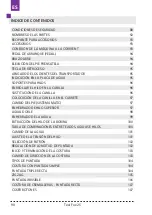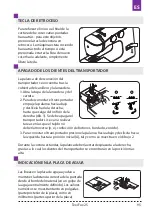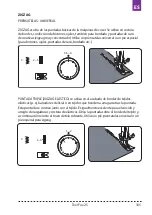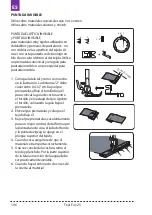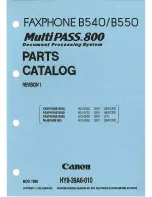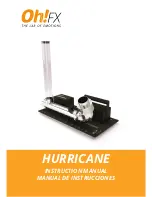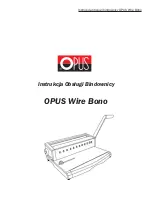
ES
TECLA DE RETROCESO
APAGADO DE LOS DIENTES DEL TRANSPORTADOR
INDICACIÓN EN LA PLACA DE AGUJA
Para reforzar el inicio o el final de la
costura debe coser varias puntadas
hacia atrás - para este objetivo,
presione la tecla de costura en
retroceso. La máquina estará cosiendo
hacia atrás todo el tiempo si está
presionada esta tecla. Para de nuevo
coser hacia adelante, simplemente
libere la tecla.
Las líneas en la placa de aguja ayudan a
mantener la distancia correcta de la puntada
desde el borde del material (en un golpe de
la aguja centralmente definido). Los valores
numéricos se muestran tanto en pulgadas
(parte posterior de la placa), como en
milímetros (parte superior de la placa).
La palanca de desconexión del
transportador se encuentra tras la
cubierta del canillero y la lanzadera.
1.
Abra la tapa de la lanzadera y del
carrete.
2.
Para desconectar el transportador
empuje la palanca hacia abajo
y deslícela hacia la derecha,
hasta que salga del orificio de la
derecha (dib. 1). Se debe apagar el
transportador si se van a realizar
tareas en las que el tejido no
debería moverse (p. ej. confección de botones, bordado, zurcido).
3.
Para conectar el transportador presione la palanca hacia abajo y deslícela hacia
la izquierda hasta la posición inicial (A), tal y como se muestra en el dibujo 2.
Durante la costura estándar, la palanca debería estar desplazada a la derecha,
gracias a lo cual los dientes del transportador se encontrarán en la posición más
alta.
4
2
1
3
KNOWING
YOUR
SEWING
MACHINE
Converting
to
free
-
arm
sewing
Your machine can be used either as a flat-bed or as a
free-arm model.
With the extension table in position, it provides a
large working surface as a standard flat-bed model.
To remove the extension table, hold it firmly with both
hands and pull it off to the left as shown. To replace,
slide the extension table back into place until it
clicks.
With the extension table removed the machine
converts into a slim free-arm model for sewing
children’s clothes, cuffs, trouser legs, and other
hard-to-reach places.
Presser foot lifter
There are three positions for your presser foot.
1. Lower the presser foot to sew.
2. Raise the lifter to the middle position to insert or remove
fabric.
3. Lift it to its highest position to change the presser foot or to
remove thick fabric.
Reverse sewing lever
As long as you are pressing down this
button while sewing, the machine will feed
the fabric backwards.
Dropping the feed dogs
1. For dropping the feed dogs, press down
lever and move it to the direction of arrow
as illustrated.
2. To raise the feed dogs, press down the
lever and move it to the direction or arrow
as illustrated.
* Feed dogs must always be up for normal
sewing.
4
2
1
3
KNOWING
YOUR
SEWING
MACHINE
Converting
to
free
-
arm
sewing
Your machine can be used either as a flat-bed or as a
free-arm model.
With the extension table in position, it provides a
large working surface as a standard flat-bed model.
To remove the extension table, hold it firmly with both
hands and pull it off to the left as shown. To replace,
slide the extension table back into place until it
clicks.
With the extension table removed the machine
converts into a slim free-arm model for sewing
children’s clothes, cuffs, trouser legs, and other
hard-to-reach places.
Presser foot lifter
There are three positions for your presser foot.
1. Lower the presser foot to sew.
2. Raise the lifter to the middle position to insert or remove
fabric.
3. Lift it to its highest position to change the presser foot or to
remove thick fabric.
Reverse sewing lever
As long as you are pressing down this
button while sewing, the machine will feed
the fabric backwards.
Dropping the feed dogs
1. For dropping the feed dogs, press down
lever and move it to the direction of arrow
as illustrated.
2. To raise the feed dogs, press down the
lever and move it to the direction or arrow
as illustrated.
* Feed dogs must always be up for normal
sewing.
5
1
2
3
KNOWING
YOUR
SEWING
MACHINE
KNOWING
YOUR
SEWING
MACHINE
Seam guide line
The numbers on the needle plate indicate
the distance between the center needle
position and the indicating line.
The numbers in the front indicate in
Millimeters.
The numbers in the back indicate in inches.
Setting spool pins
The spool pins are used for holding the spool of thread in order
to feed thread to the machine.
To use, pull up the spool pin. Push down for storage.
Winding the bobbin
1. Place a spool of thread on the left spool pin. Pull
the thread out from the spool and place it through
thread guide as shown in illustration. Put end of
thread through the hole in bobbin as shown.
2. Push the bobbin wider shaft to far left position, if
it is not already there. Place bobbin onto the
bobbin wider shaft with end of thread coming
from top of bobbin. Push bobbin winder shaft to
the right until it clicks. Hold onto end of thread.
3. Start machine. Bobbin will automatically stop
turning when completely filled. Push shaft to the
left to remove bobbin and cut thread.
Texi Fox 25
95
Содержание Fox 25
Страница 1: ...MULTIFUNCTIONAL SEWING MACHINE 2 A L K J I H G F E D C B 3...
Страница 2: ......
Страница 5: ...Texi Fox 25 5 CS...
Страница 172: ...RU 1 2 3 1 2 3 4 5 6 7 8 9 Texi Fox 25 172...
Страница 173: ...RU 10 11 12 13 14 15 16 17 Texi Fox 25 173...
Страница 175: ...RU 192 193 193 194 194 194 194 195 195 195 196 196 198 Texi Fox 25 175...
Страница 193: ...RU 1 A 2 3 4 5 6 H 3 9 2 3 Machine Setting Texi Fox 25 193...
Страница 195: ...RU 4 10 1 2 2 3 D 1 4 S S Machine Setting 10mm 3 8 Wrong side of fabric Texi Fox 25 195...
Страница 196: ...RU 4 1 2 3 4 1 2 5 6 Texi Fox 25 196...
Страница 197: ...RU 1 3 4 1 2 2 4 6 Texi Fox 25 197...
Страница 198: ...RU Texi Fox 25 198...
Страница 199: ...RU 0 0 I 0 I 2014 30 EU Texi Fox 25 199...










